Role of Inter-Organizational Information Integration in successful E-Governance
Hafiz Muhammad Afzaal1, Sameen Masood1
1Institute of Administrative Sciences, University of the Punjab, Lahore
* Correspondence: Hafiz Muhammad Afzaal E-mail : mianafxaal@gmail.com
Citation | Afzaal.H.M and Masood.M,”. Role of Inter-Organizational Information Integration in successful E-Governance. International Journal of Innovations in Science & Technology, Vol 01 Issue 03: pp 89-107, 2019.
DOI | https://doi.org/10.33411/IJIST/2019010307
Received | May 17, 2019; Revised |June 15, 2019 Accepted | June 16, 2019; Published | June 17, 2019.
________________________________________________________________________
Abstract.
The global emerging trends of E-Governance utilizes Information and Communication Technologies (ICTs) to support the governance functions. It emphases on improving governance by innovating administrative processes, transforming relationships, improving public services delivery, ensuring accountability, increasing participation and collaboration among civil society, government and private sector. Whereas, E-Governance is
considered a revolutionary reform of promoting good governance through greater control over state power, authority and resources to promote equality, peace and prosperity by eliminating corruption, unemployment and hunger. Pakistan had made huge investments on deploying ICTs infrastructure and human resource development in public sector but the country could not achieve the expected outcomes. The results show that public sector has adequate level of ICTs infrastructure and competent human resource to obtain the promising
benefits of these initiatives. However, all these resources remained underutilized which is considered a public sector dilemma in Pakistan. Most of public sector businesses are still relying on the manual systems rather than the fully computerized or automated and the public officials are bound to exchange and processes information manually. The under-utilization of these technologies and human resource cannot reap the benefits of E-Governance and the refore could not promote transparency, accountability, equality, and participation for sustainable socio-economic growth and development of Pakistan.
Keywords: E-Governance; E-Services; Inter-Organizational Information Integration and Public Sector Performance.
Introduction.
The world has noticed a digital revolution in the early 1990s, which has provided new means of interaction, collaboration and communication among individuals, organizations and societies around the world. Governments are empowering the masses through Information and Communication Technologies (ICTs) to overcome multilevel and multifaceted local as well as global challenges. The utilization of ICTs for the provision of public services under the framework of E-Governance had become essential for growth and development in the contemporary world. Whereas, the idea of E-Governance concentrated immense significance, globally, as a revolutionary trend and emerging practice of facilitating stakeholders across the territorial boundaries. The global phenomenon of E-Governance adoption became a prominent strategy for government administrative reforms [1,2,3,4,5,6].
The world has noticed a digital revolution in the early 1990s, which has provided new means of interaction, collaboration and communication among individuals, organizations and societies around the world. Governments are empowering the masses through Information and Communication Technologies (ICTs) to overcome multilevel and multifaceted local as well as global challenges. The utilization of ICTs for the provision of public services under the framework of E-Governance had become essential for growth and development in the contemporary world. Whereas, the idea of E-Governance concentrated immense significance, globally, as a revolutionary trend and emerging practice of facilitating stakeholders across the territorial boundaries. The global phenomenon of E-Governance adoption became a prominent strategy for government administrative reforms [7,8,9,10,11,12].
The technical expertise required to achieve their innovation objectives. However, the developing economies are struggling to reform their public sector and reinvent the government through utilizing ICTs under the E-Governance framework. They had introduced numerous EGovernment programs to improve public services delivery and to insure effectiveness, efficiency, accuracy, transparency and reliability. While, the deployment of ICTs in public sector under the E-Governance agenda is also considered significant in order to materialize the Good Governance [13,14,15,16,11,17].
However, there are three main dimensions of e-governance: 1) improving government processes through “e-administration”, 2) connecting citizens through “e-citizens and e-services” and 3) developing external linkages through “e-society”. E-Governance is considered a finest approach used by the governments to interact, engage and collaborate with stakeholders in an innovative and sophisticated ways and with greater efficiency, accuracy, transparency and reliability. E-Governance has shown encouraging results in developed countries for achieving sustainable growth and development [10].
Whereas, the absence of e-communication, e-collaboration and e-integration at intraorganizational and inter-organizational level, are the basic challenges confronting to public sector organizations in many countries which are identified as the most critical success factor of E-Governance. While, many researches authenticates that without the proper electronic Inter-Organizational Information Integration, efficiency in delivering public services to all stakeholders is not feasible. Furthermore, just moving from manual to computerized systems
or providing information online are not sufficient and therefore considered the underutilization of available resources which is self-destructive in actualizing the expected outcomes [18,19 20].
The basic idea of Inter-Organizational Information Integration is to enhance the scope of E-Governance by utilizing the most advance ICTs infrastructure and proficient human resource. The main objective of Inter-Organizational Information Integration is to improve the quality of public services and processes. The framework of Inter-Organizational Information Integration requires a “Central Information Storage Unit” which connects all the government departments or division to make the tedious and complex work of processing and sharing information easy, efficient and reliable without the time and space limitations. While, the popularity of E-Governance has increased the pressure on government departments to improve and enhance interaction, communication and collaboration for improving the performance of governments. Whereas, the Inter-Organizational Information Integration promotes interaction, communication and collaboration among different government bodies in order to ensure efficiency, accuracy, transparency, reliability and cost-effectiveness [21,22,23,24,25,26].
The current challenges of big data management necessitate the transformation of work places and reorganization work processes through utilizing Information Systems which is the most critical success factor of contemporary society. It is challenging to harness the potential of Information Systems to realize the outcomes of E-Governance initiatives. However, when these projects fail, the economy(ies) suffer through sever crisis and numerous socio-economic evils emerges [27,28,29,30,31].
E-Governance is not only about the computerization of the existing government processes or the digitalization of official documents [4, 27], but it aims harness optimum capacity these technologies, such as integration. However, there is no common understanding of converting manual system to fully or partially computerized system, but one thing is endorsed from the different studies and experiences of other countries is that the integration between departments in necessary which ensures real time interactions, communication,
collaboration and accessibility [26, 28].
There is no common understanding that manual system should be fully converted or partly to the computerized system, but one thing is endorsed from the different studies and experiences for achieving maximum efficiency and effectiveness the integration between departments in necessary which ultimately and definitely ensures real time interactions and accessibility in delivering public services [34,31,35,36].
E-Governance and Information and Communication Technologies
ICTs are playing a crucial role in the sustainable development efforts around the world and considered essential for modernizing economies. It improves the economic growth, production, distribution, consumption, resources allocation, national and international trade.
It is also necessary for improving public service delivery and public administration. ICTs has potential to reduce poverty and unemployment and to meet good governance goals in the developing countries [7,37].
Whereas, the idea of using ICTs by the governments in public services delivery was emerged during 1950s and the Information Systems (IS) were developed to incorporate into business organizations. While, ICTs and IS rapidly spread after the emergence of World Wide Web in the early 1990s and form the basis of E-Governance [38,5].
E-Governance and E-Government
The concept of E-Government was introduced in the United Nations General Assembly in 2000 on the adoption of Millennium Development Goals, which set out a future vision to harness the potential benefits of new technologies, especially ICTs and affirmed the availability for all [2]. Whereas, the term E-Government is applied both to the field of practice and to the domain of study. E-Government is a plan of action as well as a field of study to explore the usage of ICTs and IS to support public policies, government operations, engage
citizens and provide government services [39]. E-Government aims at ensuring that all government information must be available online for everyone to enhance accountability and transparency in order to minimize corruption in the public sector [36].
However, the term E-Governance evolved in the recent decade and often used as a substitute of E-Government. Although, the concept of E-Governance and the difference between E-Governance and E-Government is highly debatable but both involves ICTs to deliver public services. E-Governance has extensively wider scope and deals with controlling power and authority, constitution and policy making, defining the roles of actors, reforming the public administration, improving transparency and accountability, reducing corruption and violence, and transforming political, economic and socio-cultural practices [8, 13, 22].
E-Government is transforming the ways to, shares information, and to delivers services to different stakeholders.
E-Governance and E-Government
The concept of E-Government was introduced in the United Nations General Assembly in 2000 on the adoption of Millennium Development Goals, which set out a future vision to harness the potential benefits of new technologies, especially ICTs and affirmed the availability for all [2]. Whereas, the term E-Government is applied both to the field of practice and to the domain of study. E-Government is a plan of action as well as a field of study to explore the usage of ICTs and IS to support public policies, government operations, engage
citizens and provide government services [39]. E-Government aims at ensuring that all government information must be available online for everyone to enhance accountability and transparency in order to minimize corruption in the public sector [36].
However, the term E-Governance evolved in the recent decade and often used as a substitute of E-Government. Although, the concept of E-Governance and the difference between E-Governance and E-Government is highly debatable but both involves ICTs to deliver public services. E-Governance has extensively wider scope and deals with controlling power and authority, constitution and policy making, defining the roles of actors, reforming the public administration, improving transparency and accountability, reducing corruption and violence, and transforming political, economic and socio-cultural practices [8, 13, 22].
E-Government is transforming the ways to, shares information, and to delivers services to different stakeholders. It aims at harness the potential of ICTs to improve relationships with citizens, businessmen, and among different government bodies. E-Government initiatives should be the part of broader reforms to improve public sector performance [2]. The transformation towards E-Governance requires the revitalizing public sector by imparting the public service ethics and the values of welfare society. It requires greater equality, inclusiveness, participation and engagement of citizens in policy making process and public service delivery for increasing productivity transparency and accountability [14].
E-Governance and Inter-Organizational Information Integration
The inter-organizational information integration deals with the exchange of information across organizations, at different levels and also with other stakeholders in the shortest period of time with minimum cost besides the accuracy, reliability and accessibility [3,40,20]. The Integration is a critical success factor for achieving a mature level of EGovernance.
Previous researchers have identified that the inter-organizational information integration is one of the most advanced level of E-Governance which is not simply a technical matter for sharing information within and between the government departments but there is need of an innovative organizational policy, strategic planning and legal technical and framework [13]. However, the integration of information across organizational boundaries demands greater understanding of this phenomenon [14,39].
The absence of Inter-Organizational Information Integration can cause inefficient and ineffective public sector performance, which slower the economic growth and leads to sociocultural backwardness, economic fluctuations and inefficient resource allocation, loss of public trust, misuse of authority and increase corruption, crime and violence in the society. The failure of integration leads to high costs, inefficiency and inaccuracy meanwhile the loss of huge investments on ICTs and IS. However, E-Governance initiatives are lagging far behind users’ expectations in developing economies [39,41].
Unlike public sector, the private sector has strongly embraced these ideas of utilization of ICTs in business and develop E-Commerce, E-Services, and E-Banking. Now citizens and businesses are demanding efficiency, accuracy, transparency, reliability and effectiveness of public sector services [4,20]. In the said circumstances it will be very difficult and nearly impossible to deliver public services effectively and efficiently [16,6].
Material and Methods.
Investigation site.
University of the Punjab is one of the most distinguished public sector university in Pakistan which has extensively deployed ICTs infrastructure and develop proficient human resource in all departments including administration. The university had largest IT Network, Web sites and Software development center, Services Management System (SMS) and also acquired oracle-based Campus Management System (CMS).
Methods.
The study has used survey research design and a structured questionnaire, comprising 40 closed ended questions which were developed for data collection. The data was coded and entered into SPSS 23rd version prior to data analysis that applied different statistical tests such as frequency analysis, Pearson’s correlation and multinomial logistic regression. The data was collected from the network administrators working in all different departments of Punjab University. The network administrators were selected over their job
responsibilities of managing technological issues in departments including the proper functioning of computers, printers, scanners, projectors, LCDs, internet, Wi-Fi routers, CCTVs and internal and external communication networks.
Result and discussion.
The data shows the modes of services provided by the public sector, demand for different modes of services and preferences of officials. The data also unveil the literacy level including digital literacy of public officials and skills, knowledge and abilities of public officials. It also provides information about the available ICTs infrastructure, capacity of available ICTs infrastructure, and utilization of available ICTs infrastructure in public sector organizations.
Table 1. Modes of Public Services and Administrative Practices

Table 1 show the current operating mechanism of public sector organizations as well as the preferences and demands for different options. Statistics highlights that public-sector organizations neither have fully manual nor fully computerized but, hybrid system (95. 30%). While, most of the respondents (82.40% and 91.80%) show their strong preferences and demands respectively for fully computerized system in public sector organizations. However, it is evident that huge investment has been made on deploying ICTs in public sector
organizations to adopt modern administrative practices under the E-Governance initiatives but these resources had never been utilized to their greatest potential.
Table 2. Present Practices for the Exchange of Data or Information

In Table 2, the frequency analysis evaluates the present practices of exchanging data between officials and departments and highlights that most of the respondents favored Hybrid system (83.50%). Whereas, similar trends were found in the present practices of exchanging data between departments (85.90%) and Inter-Organizational Information Integration is also greatly dependent on hybrid system (80%). This trend shows the real reason behind the slow public sector performance in Pakistan. The aftermath of computerization and digitalization requires atomization and integration which is the most critical success factor of EGovernance.
Table 3. Demand and Preference of Information Integration

Table 3 is showing the respondents’ favor for fully computerized system and the same trend
was found in present practices of exchanging information between officials and departments
(70.60%). However, according to Table 1 and 2, the departments and officials are more
dependent on the hybrid system which is contrary to their demands and preferences.
Table 4. Competency, Digital Literacy and Motivation of Public Sector Officials

Table 4 shows the statistics of competencies of public officials (e.g. 10.60% = strongly agree & 69.40% = agree), which highlights that public sector organizations had competent staff who do not only understands technology but also have ability to deal with challenging situations. Whereas, results of motivational level of public officials show discouraging responses, as 51.80% remain neutral and 14.10% disagreed. However, this was asked to know whether the public-sector employees are ever encouraged, appreciated or simply motivated for adopting modern technologies for proving batter reliable public services.
Table 5. Applicability, Capacity and Utilization of ICTs in Public Sector Organizations

Table 5 presents the responses of questions about the availability, capacity and utilization of ICTs Infrastructure. shows that 82.40% strongly agreed and 17.60% were agreed. While the response for the question about the Capacity in ICTs shows that; 50.60% strongly agreed and 42.40% agreed. These responses show encouraging result and promising trend of public sector to promote modernization through deploying ICTs in all public sector organizations.
However, the responses about the utilization of ICTs infrastructure were 12.90% agreed, 60% remained neutral and 27.10% disagreed, which discouraging trend showing a dark side of public sector organizations. When one nation has resources it must utilize all these resources efficiently, effectively and in short wisely for her sustainable growth and development.
Table 6. Outcomes of E-Governance in Public Sector Organizations
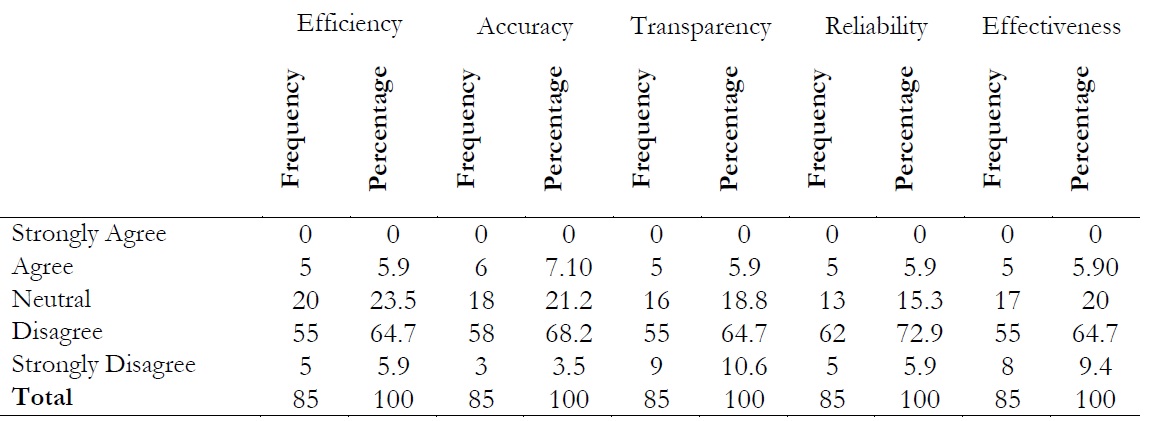
Expected outcomes are considered the most crucial aspect of any investment. As in the business studies we calculate the expected return of an investment that allows us to compare it with other opportunities. Though huge investment had been made for adopting E-Governance and different E-Government projects were started to adopt modern administrative practices by utilizing ICTs in public sector. Now the question of evaluation and calculation is getting immense importance. Therefore, this study includes questions about the
most promising benefits of deploying ICTs in public sector organizations.
From the above given table it is clear that most of the responses are in negative, such as 70.60% respondent were disagree and strongly disagree(64.70 + 5.90)about the efficiency of public sector services, 71.70% respondent were disagree and strongly disagree (68.20 + 3.50) about the accuracy in public sector working and services, 75.30% respondent were disagree and strongly disagree (64.70 + 10.60) about the accuracy in public sector working and services provision and 78.80% respondent were disagree and strongly disagree 72.90 + 5.90 about the reliability in public sector working and services provision. While, the respondents given information depicts that public sector administrative practices and the modes of services provision are neither cost effective nor accessibility. As numerical figures show that 74.10% respondent were disagree and strongly disagree (64.70 + 9.40) about the cost effectiveness in public sector working and services provision, and 75.30% respondent were disagreeing and strongly disagree (68.20 + 8.20) about the accessibility through public sector working and services provision.
Hypothesis Testing and Discussions
Hypothesis 1: There is significant association between present administrative practices and
the level of competencies (i.e. skills, knowledge and abilities) of public officials.
Table 7. Present Administrative Practices and Competencies of Public Officials
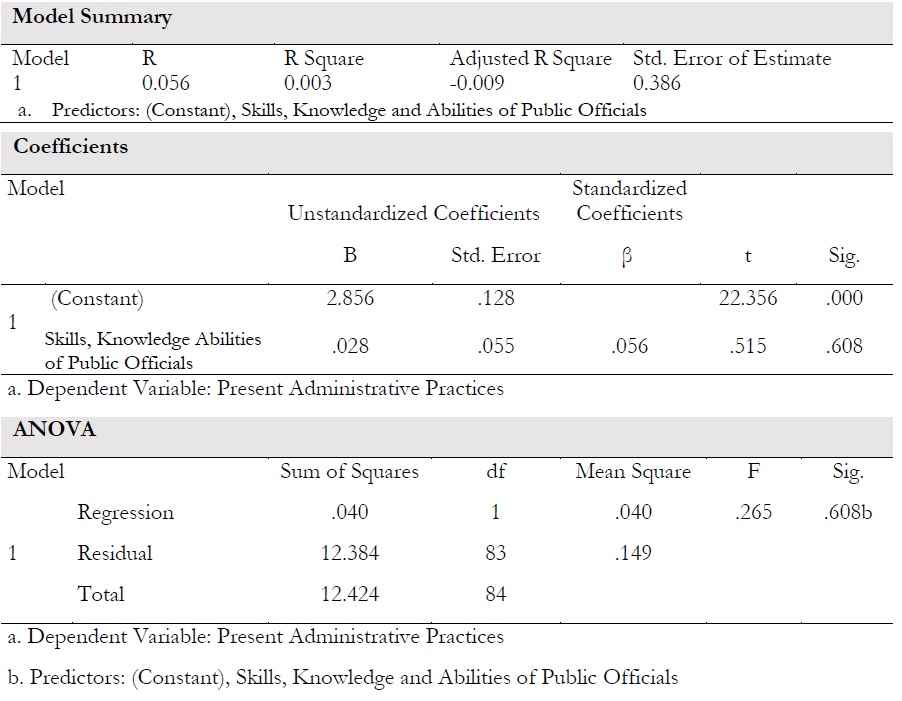
For hypothesis 1, a simple linear regression was calculated to predict present administrative practices based on the level of skills and knowledge with PU officials. A significant regression equation was found (F [1,83] = 0.265, p> .608), with an R2of 0.003). Participants’ predicted that present administrative practices are equal to 2.856 + 0.028 when the level of skills and knowledge with PU officials is measured in Likert scale. The above given information depicts that there is no significant association between the level of skills and knowledge with PU officials and present administrative practices. There is less utilization of available human resources in public sector organizations.
Hypothesis 2: There is significant association between the available ICTs infrastructure in public sector and present administrative practices.
Table 8. ICTs Infrastructure in Public Sector and Present Administrative Practices.
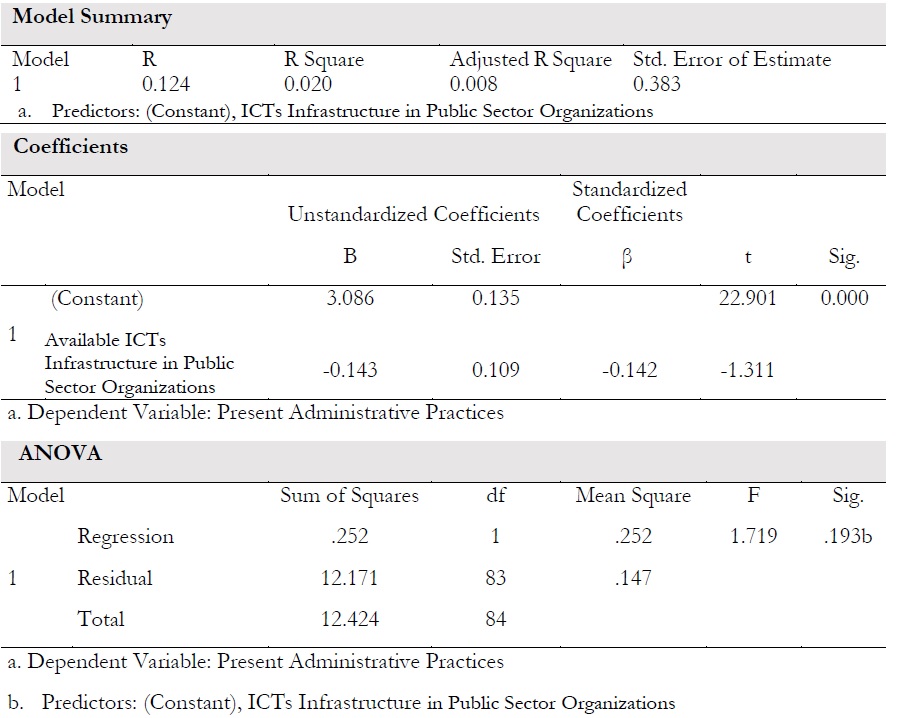
The hypothesis 2 estimates the association between the present administrative practices based on the available ICTs infrastructure in public sector organizations through linear regression analysis. Whereas, a significant regression equation was found (F [1,83] = 1.719 p>.193), with an R2 of 0.003. Participants’ predicted that present administrative practices are equal to 2.856 + 0.028 when the availability of ICTs is measured on Likert scale.
These statistics depicts that there is no significant association between the present administrative practices and ICTs infrastructure available in public sector organizations. While, only 2% change in dependent variable is occurring due to independent variable. Hence, there is very minor utilization of available ICTs infrastructure in public sector organizations.
Hypothesis 3 (a): There is relationship between the present administrative practices and input
variables.
Table 9. Correlation between Present Administrative Practices and Input Variables.
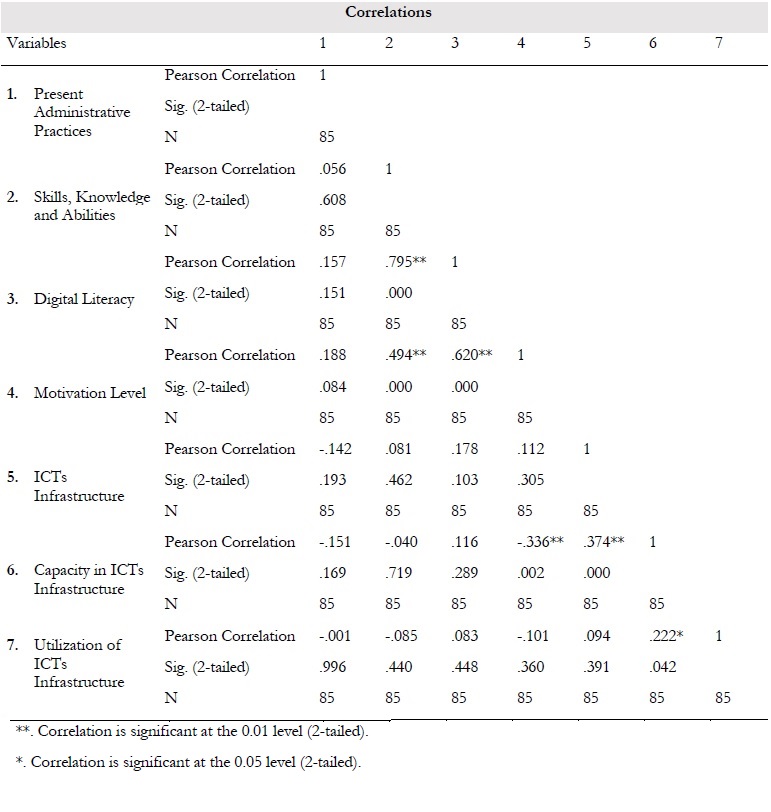
The hypothesis 3 (a) was tested through Pearson’s correlation among present administrative practices and different input variables (Skills and Knowledge, Digital literacy, Motivational Level, ICTs Infrastructure, Capacity in ICTs Infrastructure, and Utilization of ICTs Infrastructure). Table 9 presents the Pearson correlation for present administrative practices and skills and knowledge which shows weak relationship (r = 0.056, N = 85, p > α, (p= 0.608, α = 0.05). The Pearson correlation between present administrative practices and digital literacy
depicts very weak relationship (r = 0.157, N = 85, p > α, (p = 0.151, α = 0.05); the Pearson correlation between present administrative practices and motivational level is also depicts weak relationship (r = 0.188, N = 85, p > α, (p = 0.084, α = 0.05). While, the Pearson correlation between present administrative practices and ICTs Infrastructure shows negative relationship (r = -.142, N = 85, p > α, (p= 0.193, α = 0.05); the relationship between present administrative practices and capacity in ICTs Infrastructure r = -.151, N = 85, p > α, (p= 0.169, α = 0.05).Pearson correlation between present administrative practices and utilization of ICTs Infrastructure also represents negative relationship(r = -.001, N = 85, p > α, (p= 0.996, α = 0.05).
The above given numeric show that the present administrative practices are not significantly correlated with the different input variables. Although, there is no significant correlation of skills and knowledge and level of motivation, skills and knowledge and digital literacy, level of motivation and digital literacy, ICTs infrastructure and capacity in ICTs infrastructure at 0.00 significance level.
The hypothesis 3 (b) was also tested through Pearson’s correlation among different outcome variables (i.e. efficiency, accuracy, transparency, reliability, effectiveness and accessibility) and present administrative practices. The results of correlation shown in Table 10, depicts that all outcome variables such as efficiency, (r = -0.095, N = 85, p > α, (p = 0.386, α = 0.05), accuracy (r = -0.105, N = 85, p > α, (p = 0.341, α = 0.05), transparency (r = -.062, N = 85, p > α, (p = 0.576, α = 0.05), reliability (r = -.072, N = 85, p > α, (p = 0.513, α = 0.05), effectiveness (r = -0.070, N = 85, p > α, (p = 0.527, α = 0.05) and accessibility (r = -0.070, N = 85, p > α, (p = 0.527, α = 0.05) has negative relationship with present administrative practices.
These results depict that the present administrative practices are not actualizing the expected outcomes of E-Governance. However, the relationships of different outcomes with each other are strongly correlated which shows their interdependence on each other for the common goal.
Hypothesis 3 (b): There is relationship between the Present Administrative Practices and
outcome variables.
Table 10. Correlation between Present Administrative Practices and Outcome.
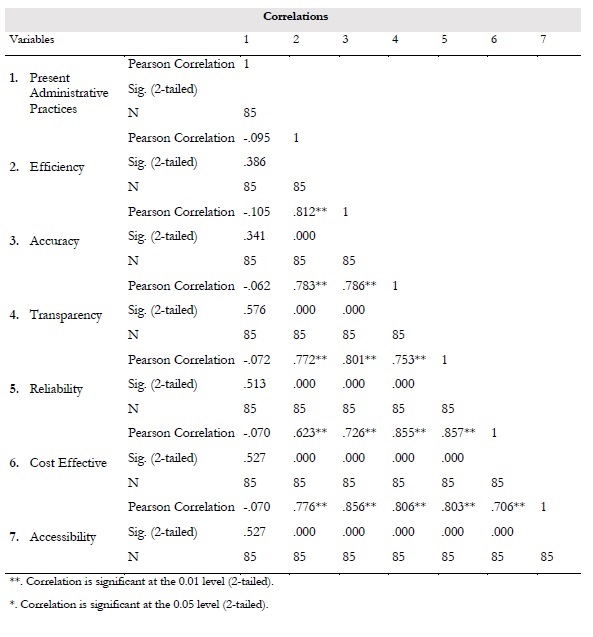
Hypothesis 4 (a): There is relationship between the Inter-Organizational Information
Integration and input variables.
Table 11. Inter-Organizational Information Integration and Input Variables.
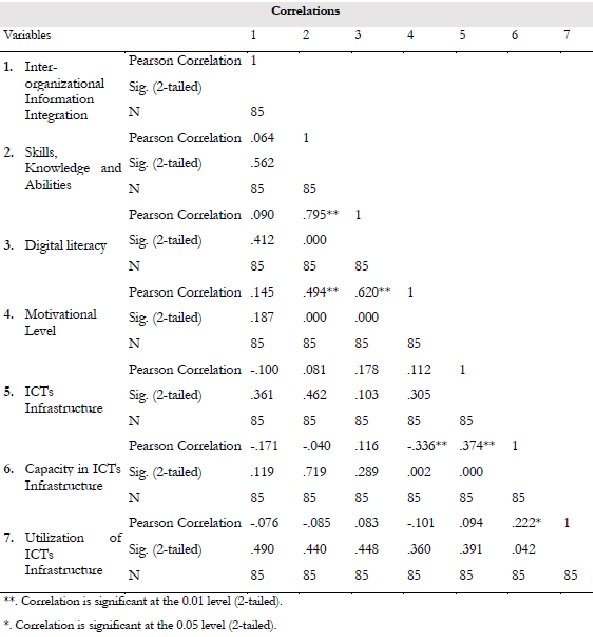
Table 11 presents the results of Pearson’s correlation among Inter-Organizational Information Integration and different input variables (i.e. skills, knowledge and abilities, digital literacy, motivational level, ICTs infrastructure availability, capacity, and utilization).
The results of Hypothesis 4 (a) illustrates that inter-organizational information has weak relationship with skills, knowledge and abilities (r = 0.064, N = 85, p > α, (p= 0.562, α = 0.05), digital literacy (r = 0.090, N = 85, p > α, (p= 0.412, α = 0.05) and motivation of public officials (r = 0.145, N = 85, p > α, (p= 0.187, α = 0.05). Whereas, the correlation between the available ICTs infrastructure (r = -0.100, N = 85, p > α, (p= 0.361, α = 0.05), the capacity of ICTs infrastructure (r = -0.171, N = 85, p > α, (p= 0.119, α = 0.05) and the utilization of ICTs
infrastructure (r = -0.076, N = 85, p > α, (p= 0.490, α = 0.05) has weak negative relationship with inter-organizational information integration.
However, these trends disclosed the under-utilization or no-utilization of available resources in public-sector organizations, to improve inter-organizational information integration for the successful E-Governance.
Whereas, the Hypothesis 4 (b) was tested through Pearson’s correlation among present administrative practices and different input variables (efficiency, accuracy, transparency, reliability, cost effectiveness, accessibility) that provide us strange results.
The results of Pearson correlation between the inter-organizational information integration and efficiency (r = -0.189, N = 85, p > α, (p = 0.083, α = 0.05), accuracy (r = - 0.201, N = 85, p > α, (p = 0.065, α = 0.05), transparency (r = -0.147, N = 85, p > α, (p = 0.179, α = 0.05), reliability (r = - 0.167, N = 85, p > α, (p = 0.127, α = 0.05), effectiveness (r= -0.157, N = 85, p > α, (p = 0.152, α = 0.05) and accessibility (r = -0.157, N = 85, p > α, (p = 0.152, α = 0.05) show the negative relationship. However, there is strong positive relationship of these outcome variables with one another. This situation depicts that present practice of inter-organizational information integration are not compatible to E-Governance strategies. While, the successful E-Governance necessitates the proper utilization of available ICTs infrastructure for inter-organizational information integration.
Hypothesis 4 (b): There is relationship between the Inter-Organizational Information
Integration and Output Variables.
Table 12. Inter-Organizational Information Integration and Output Variables.

Conclusion.
The major concern of this study was to explore the role of inter-organizational information integration in successful E-Governance. The results reveal that the public sector organizations in Pakistan are not utilizing the available resources (e.g. ICTs and competent human resource) to their optimum level despite having the potential capacity. While, the underutilization of these resources not only cost the government but instigating backwardness of public sector organizations in Pakistan. Whereas, this survey also highlights the differences
in present practices, officials’ preferences and stakeholders’ demands. However, the findings revealed the positive attitude of respondents towards the inter-organizational information integration for greater efficiency, accuracy, transparency, accountability and reliability of public sector processes.
Acknowledgement.
Author’s Contribution. All the authors contributed equally.
Conflict of interest. We declare no conflict of interest for publishing this manuscript in IJIST.
Project details. NIL
References:
1. Alfred T. H., (2002). Reinventing Local Governments and the E-Government Initiative. American Society for Public Administration, Public Administration Review, 62(4), 3-9.
2. United Nation Public Administration Network, (2004). UN Global E-Government Survey. UN publications, New York.
3. Lam W., (2005). Barriers to e-government integration. Journal of Enterprise Information Management, 18(5), 511 – 530.
4. Zhao F., Scavarda A.J. &Waxin M.F. (2012). Key issues and challenges in e-government development: an integrative case study of the number one eCity in the Arab world. Information Technology & People, 25(4), 395-422.
5. Bannister F., & Connolly R. (2012). Defining E-governance. E-Service Journal, 8(2), 3-25.
6. Sujeet K. S., (2015). Adoption of e-government services, Transforming Government: People, Process and Policy, 9(2), 207 – 222.
7. Heeks R. (1999). Reinventing Government in the Information Age: International Practice in IT-enabled Public Sector Reform. New York: Routledge.
8. Fountain J.E. (2001). Building the Virtual State. Information Technology and Institutional Change. Washington, DC: Brookings Institution Press.
9. KraemerK.L., & King J.L. (2003). Information technology and administrative reform: Will the time after e-government be different? Post Graduate School of Administration, Speyer, Germany.
10. Nirmaljeet S. K., &Kiran R., (2012). E-governance success factors: An analysis of Egovernance initiatives of ten major states of India. International Journal of Public Sector
Management, 26(4), 320 – 336.
11. Jain V., (2014) E-governance: An emerging paradigm. Golden Research Thoughts, 4(4), 1-7.
12. United Nation Public Administration Network, (2014). E-Government for The Future We Want. UN publications, New York.
13. Cresswell A.M., Canestraro D.S., Gil-García J.R., Pardo T.A., and Schneider C., (2004). Inter-organizational information integration: Lessons from the field. Paper presented at the Sixty-fifth ASPA National Conference, Portland.
14. Gil-Garcia J.R., Schneider C., Pardo T.A., and Cresswell A.M., (2005). Interorganizational information integration in the criminal justice enterprise: Preliminary lessons from state and county initiatives. Los Alamitos, Computer Society Press.
15. France B., &Janine S. H., (2006). A framework for e-government: privacy implications. Business Process Management Journal, 12(1), 48 – 60.
16. Smallwood R. F., (2014). Information governance: Concepts, strategies, and best practices (1sted.). John Wiley & Sons Ltd: US.
17. Myeong S., Kwon Y., & Seo H., (2014). Sustainable E-governance: The relationship among trust, digital divide, and E-government. Sustainability, 6(9), 6049-6069.
doi:10.3390/su6096049
18. Sung J. P., (2002).IT-Enabled Supply Chain Management: Impact Of Inter-Organizational Information Systems on Supply Chain Performance. Graduate School of State University, Buffalo, New York, ProQuest Information and Learning Company.
19. Dolly A. H., (2011). Making Sense of Information Sharing in E-Government Inter- Organizational Collaborations: A Malaysian Perspective. Claremont Graduate University, ProQuest LLC.
20. Christina W.Y.W., Kee-hungLai T.C.E., Cheng, Y.H., VenusL., (2014). The role of IT enabled collaborative decision making in inter-organizational information integration to improve customer service performance. International Journal of Production Economics, Elsevier
21. Norris D. F., & Moon J. M., (2005). Advancing E-Government at the Grassroots: Tortoise or Hare? Public Administration Review, 65(1).
22. Tubtimhin J., & Pipe R., (2009). Global e-governance: Advancing e-governance through innovation and leadership. Amsterdam: IOS Press.
23. ReddickG. C., (2010). Comparative E-Government: Integrated Series in Information System. Springer New York.
24. Irfanullah A., and Nawar K., (2010). Public Sector Innovation: Case Study of E government Projects in Pakistan. Pakistan Institute of Development Economics, The Pakistan Development Review, 48(4).
25. Sultana F. N., & Finger, M. (2012). E-governance, A global journey. NL: IOS Press.
26. Okoronkwo M. C., &Monica N. A., (2013). Providing E-governance services to technologically challenged grassroots environments. International Journal of Soft Computing & Engineering, 3(1), 107-111.
27. Holmes D. 2001.E-Gov: E-Business Strategies for Government. London: Nicholas Brealey.
28. Landsbergen D., &Wolken G., (2001). Realizing the Promise: Government Information Systems and the Fourth Generation of Information Technology.
29. Gant D.B., Gant J.P., & Johnson C.L., 2002.State Web Portals: Delivering and Financing EService. Arlington, VA: PricewaterhouseCoopers Endowment for the Business of Government.
30. Garson G.D. 2004. The promise of digital government: Digital Government: Principles and
Best Practices, 2– 15. Hershey, PA: Idea Group.
31. Ailsa L. K., (2008). Citizens' attitudes towards e-government and E-Governance, a UK
study. International Journal of Public Sector Management, 21(7).
32. Milakovich M. E., (2012). Digital governance. New technologies for improving public
service and participation. New York/London: Routledge.
33. Palvia, S. & Sharma S., (2010). E-Government and E-Governance: Definitions/Domain Framework and Status around the World. Computer Society of India.
34. Richard R., (2005). A Global Diffusion Model of e-Governance. Journal of Public Policy, 25,
5-27 doi: DOI:10.1017/S0143814X05000279
35. Sameer G., Rajeev D., &SherryA. M., (2013). Critical Factors for Successful Implementation of E-governance Programs: A Case Study of HUDA. Global Journal of Flexible Systems Management, 13(4): 233–244 DOI 10.1007/s40171-013-0021-1
36. Stephen M. M. &Kelvin J. B., (2014). E-government: implementation, adoption and
synthesis in developing countries. Global Studies in Libraries and Information. De Gruyter.
37. Helena S. C., & Álvaro D., (2014). Administrative reforms and performance of local public
policies. International Journal of Public Sector Management, 27(6), 462 – 474.
38. Bertoletti M.; Missier P.; Scannapiego M.; Aimetti P.; and Batini C. (2005). Improving
government-tobusiness relationships through data reconciliation and process
reengineering.NY.
39. Scholl H.J.,ed. (2007). Transforming Government: People, Process and Policy.Armonk, NY,
USA: M.E. Sharpe.
40. Otjacques B.,Hitzelberger P., &Feltz F. (2007). Interoperability of e-government information
systems: issues of identification and data sharing. Journal of Management Information
Systems, 23(4), 29– 51.
41. Anttiroiko A., Bailey S. J., & Valkama P. (2011). Innovations in public governance. NL: IOS
Press.




















